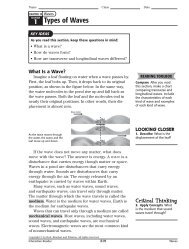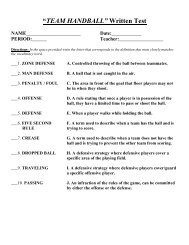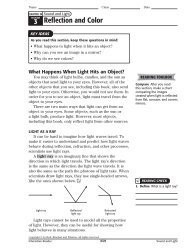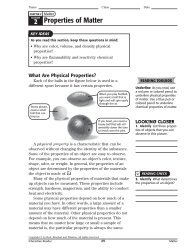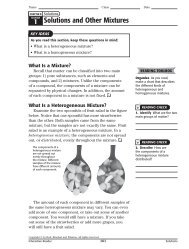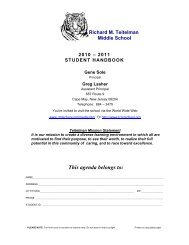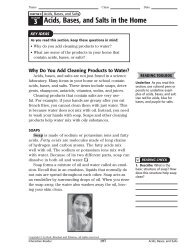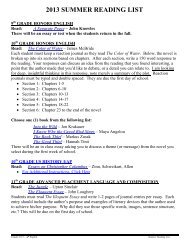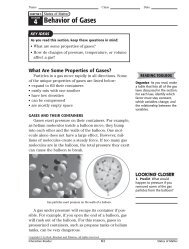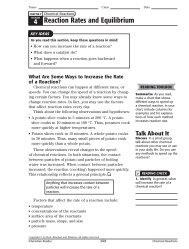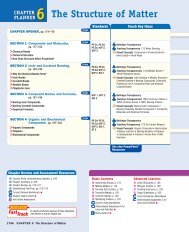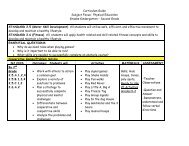Fluids 3 - Lower Cape May Regional School District
Fluids 3 - Lower Cape May Regional School District
Fluids 3 - Lower Cape May Regional School District
Create successful ePaper yourself
Turn your PDF publications into a flip-book with our unique Google optimized e-Paper software.
Name Class Date<br />
CHAPTER 3<br />
SECTION<br />
3<br />
States of Matter<br />
<strong>Fluids</strong><br />
KEY IDEAS<br />
As you read this section, keep these questions in mind:<br />
• How do fluids exert pressure<br />
• What causes objects to float<br />
• What happens when pressure in a fluid changes<br />
• What affects the speed of a fluid<br />
What Are <strong>Fluids</strong><br />
Recall that liquids and gases are examples of fluids.<br />
The particles in a fluid can move past each other. <strong>Fluids</strong><br />
exert pressure, or push, evenly in all directions. The properties<br />
of fluids allow ships to float, divers to explore the<br />
ocean, and jets to soar across the sky.<br />
What Is Pressure<br />
Pressure is the amount of force exerted on a given<br />
area of surface. For example, when you add air to a bicycle<br />
tire, you push air into the tire. Inside the tire, the air<br />
molecules push against each other and also against the<br />
walls of the tire. As you pump more air into the tire, the<br />
pressure inside the tire increases. Why More air particles<br />
are pushing against the inside of the tire and against each<br />
other.<br />
The force of air particles inside<br />
the tire creates pressure. Pressure<br />
keeps the tire firm.<br />
READING TOOLBOX<br />
Summarize As you read,<br />
write down each scientific<br />
law or principle described in<br />
this section. Write each one<br />
in your own words. Include a<br />
diagram or equation that describes<br />
the principle or law.<br />
<br />
1. Predict What would<br />
happen to pressure in the tire<br />
if some of the air were<br />
removed Explain your answer.<br />
CALCULATING PRESSURE<br />
You can calculate pressure by dividing the force by the<br />
area over which the force acts. The equation for calculating<br />
pressure is on the next page.<br />
Copyright © by Holt, Rinehart and Winston. All rights reserved.<br />
Interactive Reader 55 States of Matter
Name Class Date<br />
SECTION 3<br />
<strong>Fluids</strong> continued<br />
Pressure<br />
pressure = _____ force<br />
area<br />
P = F__ A<br />
READING CHECK<br />
2. Identify What is the SI<br />
unit of pressure<br />
<br />
Discuss According to legend,<br />
Archimedes helped a king<br />
determine if his crown was<br />
made of pure gold or of silver.<br />
With a partner, discuss ways<br />
to use Archimedes’ principle<br />
to help the king learn if his<br />
crown was made of gold.<br />
(Hint: The density of silver is<br />
less than the density of gold.)<br />
The SI unit of pressure is the pascal. One pascal<br />
(1 Pa) is the force of one newton exerted over an area of<br />
one square meter (1 N/m 2 ). The newton is the SI unit of<br />
force.<br />
What Causes an Object to Float<br />
What happens if you push a rubber duck to the bottom<br />
of a tub and release it It does not sink to the bottom of<br />
the tub. It pops up to the surface. Why does this happen<br />
A force called the buoyant force pushes the rubber duck<br />
upward. All fluids exert an upward buoyant force on matter.<br />
You may feel this force when you float on your back<br />
in a pool or lake.<br />
DETERMINING BUOYANT FORCE<br />
A Greek mathematician named Archimedes discovered<br />
a method to determine buoyant force.<br />
Archimedes’ Principle<br />
The buoyant force on an object equals the<br />
weight of the fluid that the object displaces.<br />
The figure below shows how to find the buoyant force<br />
on an object.<br />
<br />
3. Identify Relationships<br />
What does the volume of<br />
displaced water equal<br />
<strong>Lower</strong> an object into a<br />
container of water.<br />
The object displaces<br />
water. The displaced<br />
water flows into a<br />
smaller container.<br />
When water covers the<br />
object completely, you<br />
can measure the volume<br />
of the displaced<br />
water. The volume of<br />
the water equals the<br />
volume of the object.<br />
Once you have collected the displaced water, you can<br />
find its weight. The weight of the displaced water equals<br />
the buoyant force.<br />
Copyright © by Holt, Rinehart and Winston. All rights reserved.<br />
Interactive Reader 56 States of Matter
Name Class Date<br />
SECTION 3<br />
<strong>Fluids</strong> continued<br />
DETERMINING IF AN OBJECT WILL SINK OR FLOAT<br />
You can predict if an object will sink or float by comparing<br />
its weight with the buoyant force on it. An object<br />
floats when the buoyant force is greater than or equal to<br />
the object’s weight.<br />
<br />
4. Analyze If an object’s<br />
weight is less than the buoyant<br />
force, will it sink or float<br />
You can also compare the densities of a fluid and<br />
an object to predict if the object will float. If the object<br />
is denser than the fluid, it will sink. For example, the<br />
density of a brick is 2 g/cm 3 . The density of water is<br />
1.00 g/cm 3 . The brick is denser than water and thus will<br />
sink in water.<br />
Steel is almost eight times denser than water.<br />
However, large ships made of steel can float in the ocean.<br />
Why The shape of the boat allows it to float. Because a<br />
large part of the boat is hollow, the same mass of steel<br />
takes up a larger volume. Increasing volume decreases<br />
overall density and the boat floats.<br />
<br />
5. Explain Why does a block<br />
of steel have a larger density<br />
than a boat made of steel<br />
A large part of the boat is hollow. Although shape<br />
does not change the mass of the boat, the volume of<br />
the hollow boat is larger. A larger volume for a particular<br />
mass reduces the density of the boat.<br />
A block of steel is<br />
denser than water,<br />
so the block sinks.<br />
Copyright © by Holt, Rinehart and Winston. All rights reserved.<br />
Interactive Reader 57 States of Matter
Name Class Date<br />
SECTION 3<br />
<strong>Fluids</strong> continued<br />
What Happens When Pressure Changes in a<br />
Fluid<br />
What happens when you squeeze one end of a tube of<br />
toothpaste The pressure you apply at one end is passed<br />
along throughout the entire tube. This causes toothpaste<br />
to come out the other end. In the 17 th century, a French<br />
scientist named Blaise Pascal explained this kind of<br />
observation.<br />
Pascal’s Principle<br />
If the pressure in a container is increased at any point,<br />
the pressure increases at all points by the same amount.<br />
<br />
6. Identify What do the variables<br />
P, F, and A represent<br />
Pascal’s principle can be stated by the following<br />
equations:<br />
Pascal’s Principle<br />
P 1<br />
= P 2<br />
P = F__ A<br />
Therefore, ___<br />
F 1<br />
= ___<br />
F 2<br />
A 1<br />
A 2<br />
Math<br />
Skills<br />
7. Calculate A hydraulic lift<br />
uses Pascal’s principle to lift<br />
a 19,000 N car. The area of<br />
the small piston equals<br />
10.5 cm 2 and the area of<br />
the large piston equals<br />
400 cm 2 . What force must<br />
you exert on the small<br />
piston to lift the car<br />
HYDRAULIC DEVICES<br />
Hydraulic devices are based on Pascal’s principle.<br />
Hydraulic devices use liquids to transmit, or pass,<br />
pressure from one point to another. They can be used<br />
to multiply force.<br />
A small downward force is applied<br />
to a small area. This force exerts<br />
pressure on the fluid in the device.<br />
Force 1<br />
Area 1<br />
Area 2<br />
Force 2<br />
The pressure is<br />
transmitted to a<br />
larger area, where<br />
the pressure creates<br />
a larger force.<br />
According to Pascal’s principle, the pressure is the same on both sides of the<br />
fluid in the device. Therefore, a small force on a smaller area produces a larger<br />
force on the larger area.<br />
Copyright © by Holt, Rinehart and Winston. All rights reserved.<br />
What Are the Properties of <strong>Fluids</strong> in Motion<br />
Examples of moving fluids include liquds flowing<br />
through pipes, air moving as wind, and honey dripping.<br />
<strong>Fluids</strong> can flow at different rates. However, fluids in<br />
motion have some properties in common.<br />
Interactive Reader 58 States of Matter
Name Class Date<br />
SECTION 3<br />
<strong>Fluids</strong> continued<br />
FLUIDS AND AREA<br />
If the flow rate stays the same, fluids move faster<br />
through small areas than through large areas. For example,<br />
if you place your thumb over the end of a garden<br />
hose, your thumb blocks part of the opening. The water<br />
must flow through a small area. Because the area is<br />
small, the water leaves the hose at a faster speed.<br />
FLUID PRESSURE AND SPEED<br />
Imagine water carrying a leaf through a pipe. The<br />
water moves faster through the narrow part of the pipe<br />
than through the wider part. Therefore, the leaf carried<br />
by the water moves more quickly in the narrow part of<br />
the pipe. The water pressure behind the leaf is greater<br />
than the pressure in front of the leaf. The pressure difference<br />
causes the leaf to speed up, or accelerate, as it<br />
enters the narrow tube.<br />
READING CHECK<br />
8. Describe How does area<br />
affect the speed of a fluid<br />
More pressure<br />
Less pressure<br />
Pressure is lower in the narrow<br />
part of the pipe than in the<br />
wide part. As the leaf enters<br />
the narrow part, the pressure in<br />
front of the leaf is less than the<br />
pressure behind it. Thus, the<br />
leaf speeds up when it enters<br />
the narrow part of the pipe.<br />
<br />
9. Identify On the diagram,<br />
write the words slower and<br />
faster to show how speed<br />
differs in different parts of<br />
the tube.<br />
A Swiss mathematician named Daniel Bernoulli<br />
described this property of a moving fluid.<br />
Bernoulli’s Principle<br />
As the speed of a moving fluid increases, the<br />
pressure of the moving fluid decreases.<br />
VISCOSITY<br />
Some fluids move much more slowly than others. For<br />
example, it would take you longer to pour a cup of honey<br />
than a cup of water. Another way to say this is that different<br />
fluids have different viscosities. Viscosity is a fluid’s<br />
resistance to flow. A viscous fluid does not flow as easily<br />
as a less viscous fluid. In general, the stronger the attraction<br />
between the particles of a fluid, the more viscous the<br />
fluid is.<br />
Copyright © by Holt, Rinehart and Winston. All rights reserved.<br />
Interactive Reader 59 States of Matter
Name Class Date<br />
Section 3 Review<br />
SECTION VOCABULARY<br />
buoyant force the upward force that keeps an<br />
object immersed in or floating on a fluid<br />
pascal the SI unit of pressure; equal to the<br />
force of 1 N exerted over an area of 1 m 2<br />
(symbol, Pa)<br />
pressure the amount of force exerted per unit<br />
area of a surface<br />
viscosity the resistance of a gas or liquid to flow<br />
1. Describe How can you use density to determine if an object will sink or float in a<br />
fluid<br />
2. Analyze You put a small object into a cup of water and weigh the displaced water.<br />
The displaced water weighs 235 N. What is the buoyant force on the object<br />
Explain your answer.<br />
3. Explain How does a hydraulic device multiply force<br />
4. Infer A balloon filled with helium floats in the air. What does this tell you about<br />
the density of helium<br />
5. Explain How are speed and pressure of a fluid related<br />
6. Explain How do the attractions between particles in a fluid determine viscosity<br />
Copyright © by Holt, Rinehart and Winston. All rights reserved.<br />
Interactive Reader 60 States of Matter



